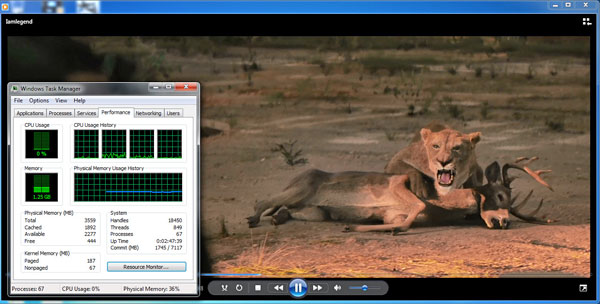AMD Trinity A10-4600M Processor Review
Test Methodology, HD Video Playback and Transcoding
Test Methodology: As you'll note in the following pages of benchmarks, we've compared the AMD Trinity notebook to a few different machines, both standard notebooks and in some cases Ultrabook class products. In every test case, we tried to leave each notebook as delivered to us from the manufacturers. This meant, after any pending Windows updates were installed, we disabled Windows update and also disabled any virus scanning software that may have been installed, so it wouldn't kick in during benchmark runs.
That said, it's virtually impossible to ensure identical system configurations between notebooks; so we'll caution you that reference scores from the various test systems are listed in order to give you a general feel for performance between these similar class of machines and not for direct, apples-to-apples comparisons.
As a quick sanity check on CPU utilization during multimedia playback, we first fired up a 1080p QuickTime video clip from the Apple QuickTime Movie Trailer gallery. Here we've captured a scene from the movie trailer for I am Legend so you can get a look at how AMD's new Trinity A10-4600M handles HD video decoding workloads.
Windows Task Manager's Performance monitor shows the new quad-core chip is oscillating between 0 - 5% CPU utilization, which is a little lower actually than what we saw with Intel's Ivy Bridge mobile chip. Apparently AMD's new HD Media Accelerator engine is no joke in Trinity, at least with respect to H.264-based video decode and playback.
Cyberlink's MediaEspresso is a video conversion tool that imports various video media files types and converts them to other standard video types for publication, portability and streaming. In this test, we take a 224MB high definition 1080p AVCHD video clip and convert it to a 720p H.264-encoded video file. Here we're going to look directly at AMD's HD Media Accelerator in the new A10 APU and compare it to Intel's previous generation Sandy Bridge Quick Sync engine, Ivy Bridge's new Quick Sync engine, and competitive CPU-based solutions as well.
Times are measured in minutes:seconds with lower times representing faster throughput in the video conversion process.

That said, it's virtually impossible to ensure identical system configurations between notebooks; so we'll caution you that reference scores from the various test systems are listed in order to give you a general feel for performance between these similar class of machines and not for direct, apples-to-apples comparisons.
|
As a quick sanity check on CPU utilization during multimedia playback, we first fired up a 1080p QuickTime video clip from the Apple QuickTime Movie Trailer gallery. Here we've captured a scene from the movie trailer for I am Legend so you can get a look at how AMD's new Trinity A10-4600M handles HD video decoding workloads.
1080p H.264 Encoded QuickTime Trailer Playback
Windows Task Manager's Performance monitor shows the new quad-core chip is oscillating between 0 - 5% CPU utilization, which is a little lower actually than what we saw with Intel's Ivy Bridge mobile chip. Apparently AMD's new HD Media Accelerator engine is no joke in Trinity, at least with respect to H.264-based video decode and playback.
|
Times are measured in minutes:seconds with lower times representing faster throughput in the video conversion process.

There's not a lot more to say here than what the benchmark numbers don't speak clearly. We tested the AMD optimized version of this app that takes advantage of AMD's AVC engine for hardware accelerated video conversion from AVCHD to H.264. Though it certainly knocked a bunch of time off the software only, unaccelerated test, AMD's Accelerated Video Converter technology couldn't even begin to compete with Intel Quick Sync. In addition, as you can see in the screen shot of the app above this graph, Trinity is reporting over 60% CPU utilization whereas Ivy Bridge reported 12% utilization when transcoding this video workload.








